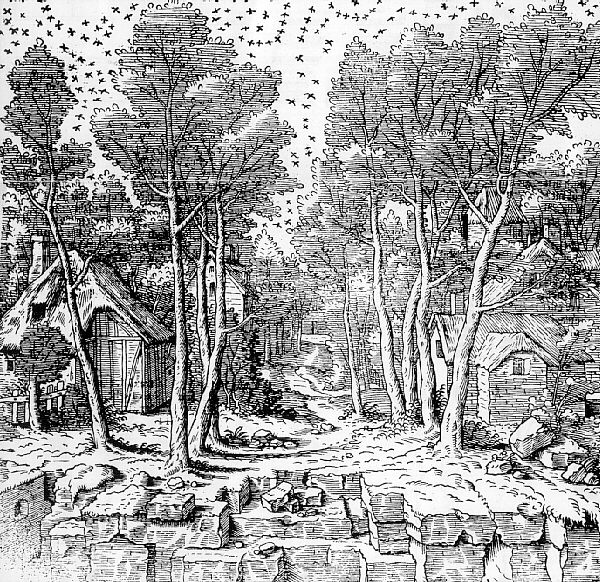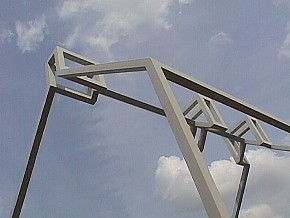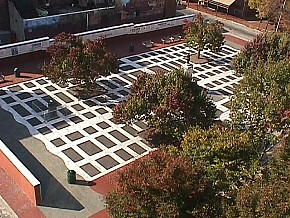1999.04.01 21:32
aesthetics of war design
...or, if you take an inverted view, maybe it's all just a (theoretical) war of (philosophical) ruins...
1999.05.04 12:56
Designs That Stink
Given the fact that the (European) medieval church left a largely unsurpassed architectural legacy, the comparison between the medieval church and the modern cinema in all its manifestations may not distribute altogether evenly. Granted, the act of "worship" (and patronage) emanating from modern cinema's public (masses) compares well with religious fervor, however, the legacy of this "adoration" falls largely in the bank accounts of movie executives--essentially the medium that increasingly controls more and more of our culture is unprovisionally paid by the masses to do so--and those executives love the fact that people continue to unobjectionably pay more and more. Perhaps a comparison between modern cinema and ancient paganism provides a more apt equation.
As I grow older, it becomes clearer and clearer to me that regardless of the reality, many people choose to believe that which least offends or threatens them.
ps
Isn't India the real world capital of modern cinema? And therefore wouldn't a comparison between modern cinema and Hindu temples make for an even better learning lesson?
1999.05.04 15:35
Re: (Designs That) Stinking Heights
John, I'm very glad that you mentioned "Beauvais's overreaching collapse."
For the benefit of all, Beauvais's St. Pierre Cathedral spire (c. 1570s) was the first building to exceed the height of the Great Pyramid at Giza, which until then remained the tallest building in the world. Unfortunately, the Beauvais spire fell after standing only approximately 75 years, however, the main vault of the catherdal is still the highest stone arch in the world.
One could then say that the Great Pyramid regained its "tallest" status, except by that time the second pyramid of Giza may have already been taller than the Great Pyramid (like it is today--this differential is due to the great Pyramid's full point no longer being there).
the Great Pyramid was 480 ft tall
the second pyramid is 470 ft tall
Beauvais's spire was 500 ft tall
Regardless of whether the Great or second pryamid held the "world's tallest record," neither was surpassed until the 1850s when the Washington Monument reached the height of 555 ft. What I find most interesting is that after more than four millennia of the pyramids holding the world's tallest title, they were uncannily surpassed by another ancient Egyptian form! As those wonderful ancient Egyptian cheerleaders used to say, "Ra! Ra! Ra!"
1999.09.27 17:25
class
Class: I guess now-a-days and all-around, class is largely measured by what one buys.
| |
1999.10.05 13:12
who's on first?
The following exerpt comes from Johan Huizinga's Homo Ludens - a study of the play element in culture:
"The player who transpasses against the rules or ignores them is a "spoil-sport". The spoil-sport is not the same as the false player, the cheat; for the latter pretends to be playing the game and, on the face of it, still acknowledges the magic circle. It is curious to note how much more lenient society is to the cheat than to the spoil-sport. This is because the spoil-sport shatters the play-world itself. By withdrawing from the game he reveals the relativity and fragility of the play-world in which he had temporarily shut himself with others. He robs play of its illusion -- a pregnant word which means literally "in-play" (from inlusio, illudere or inludere). Therefore he must be cast out, for he threatens the existence of the play-community. . . . In the world of high seriousness, too, the cheat and the hypocrite have always had an easier time of it than the spoil-sport, here called apostates, heretics, innovators, prophets, conscientious objectors, etc. It sometimes happens, however, that the spoil-sports in their turn make a new community with rules of its own. The outlaw, the revolutionary, the cabbalist or member of a secret society, indeed heretics of all kinds are of a highly associative if not sociable disposition, and a certain element of play is prominent in all their doings."

Scena Rustica or Scena Satirica
1999.11.09 10:28
reenactment
Again thanks for you comments/critique. If reenactment as a design prescription is still only a "weak hypothesis," your consideration of the notion so far certainly contributes supplemental vitality and strength.
The evocation of Serlio's 'street scenes' is indeed apt--the notion of stage set is very much part of reenactment, i.e., the place upon which and within which to 'act' again (and again). For the record, Serlio drew three scenes, the third, Scena Rustica or Scena Satirica, is all natural/naturalistic (proto-primitive hut? or proto-romanticism?).
While reenactment certainly necessitates a contextual understanding, reenactment as a design paradigm is nonetheless not necessarily site specific. For example, theme parks everywhere are for the most part far removed for the 'actual' themes they reenact. On the other hand, the reenactments within Venturi (Rauch) and Scott Brown's Franklin Court (Philadelphia), Western Plaza (Washington D.C.) and Welcome Park (Philadelphia) relate directly to their respective sites/environments. Reenactment then can (and indeed does) have it both ways in terms of context.
 
As to the "problem" of "exciting ideas" never getting developed due to being brightly spotlighted and then quickly moved on from, perhaps this 'trendy' behavior too is a form of reenactment, that is, a repetitious renewal, the continual process of putting on a new hat, but always putting on a hat nonetheless.
The best philosophy I've read so far that purports reenactment is within Collingwood's The Idea of History. Collingwood is much influenced by Croce, and Croce is much influenced by Vico.
When I first began to redraw Piranesi's Campo Marzio using CAD, I was doing so to get as close to Piranesi as possible; essentially, I was reenacting his act of drawing as best I could. For me, this exercise, this reenactment, has provided enormous insight albeit it took several years of continual work for this vision to develop. I am certainly not Piranesi, nor do I contend to possess his superior creative talent and imagination, but I deliberately attempted to do some of the same things he has done, and in so doing I honestly believe I removed several degrees of separation. Perhaps reenactments then are always a play with degrees of separation, sometimes seeing how close one can get to the 'original' and/or sometimes seeing how far one can "stretch the truth," to name the extreme cases.
| |
1999.12.04 06:58
[priv]
I'm (spot) reading Hilde Heynen's Architecture and Modernity (MIT Press, 1999). Hilde was a member of NeTHCA's (Network for Theory, History and Criticism of Architecture, Belgium) scientific committee which selected my paper for INSIDE DENSITY. Hilde was also a key organizer of INSIDE DENSITY, and she recognized reenactment as a powerful concept. Her book towards the end deals with mimesis, and I now see further how mimesis and reenactment cut a similar profile, but I also see how the concept of reenactment potentially manifests an annexation of mimesis.
2000.02.03 11:43
an answer to "Now what?"
Hugh Pearman states and asks:
Such being the case, we can conclude that Decon has run out of steam as a manifesto-led movement, and we must look to its successor. Ideas, anyone?
Steve Lauf replies:
Is Decon the only thing to have run out of steam? Has the now pervasive and generally accepted way of looking at and being critical of architecture also run out of steam? For example, does moving from seeing Decon as reactionary to now (maybe) seeing the New Austerity as the latest reaction really convey a sense of meaning beyond the oscillations of fashion and trend? Has each new "critical" building become nothing more than the latest "creation" of the now global fashion show? Likewise, has the element of shock become ingrained within the (elite) architectural profession, the same way shock has become "stock-in-trade" in a good deal of high fashion? [I'm not saying there is anything wrong with the architecture that receives attention and the industry surrounding it being akin to the fashion industry, but I do think there is something wrong about not recognizing the phenomenon as such.]
Here's how I now look critically at architecture (and urban design) both currently and historically:
What architecture is extreme?
What architecture is fertile?
What architecture is pregnant?
What architecture is assimilating?
What architecture is metabolic?
What architecture is osmotic?
What architecture is electromagnetic?
What architecture manifests the highest frequencies?
What I've found so far is that some architectures fall straight into some of the categories above while some architectures are categorical hybrids. Here are some examples:
the Pyramids, Stonehenge, St. Peter's (Vatican), Bilbao(?)--extreme, extreme architectures.
the Pantheon, Hall of Mirrors, Versailles, entry sequence of Schinkel's Altes Museum, Kimbell Art Gallery -- examples of the best osmotic architecture there is.
Classical Greek and Roman Architecture--pure architecture of fertility.
the Hindu Templ --the ultimate transcendence from an architecture of fertility to an architecture of pregnancy, whereas the Gothic Cathedral is an architecture of pregnancy, albeit virginal.
all of 20th century Berlin--the metabolic (create and destroy and create and destroy and ...)
To understand architecture of assimilation, look at the Renaissance, but also look to early 20th century Purism to understand assimilation in the extreme, i.e., purge.
Today's architectures are by and large assimilating and/or metabolic (contextual and/or 'deconstructivist'?).
You're very lucky if you ever see pure examples of electromagnetic or frequency architectures today because they are almost entirely architectures of the far off future.
There are many more examples to offer, but that's all for now.
In general, I see all architectures as reenactionary (as opposed to reactionary).
Architecture reenacts human imagination, and human imagination reenacts the way the human body is and operates. The human body and the design thereof is THE enactment. The human imagination then reenacts corporal morphology and physiology, and architecture then reenacts our reenacting imaginations.
| |
2000.02.03 15:08
austerity = extreme assimilation?
In Hugh Pearman's piece on the New Art Gallery in Walsall, he begins with:
"If you could distill the essence of pure modern architecture, and remove all traces of the usual compromises and cut corners and clumsy details and flash populist moves, then you would get a strange, unsettling, austere, but rather beautiful building."
This sentence well describes what I mean by an architecture of extreme assimilation. Assimilation in physiological terms means the absorption of nutrients, and this corporal operation occurs primarily within the intestines. The final stage of assimilation is then in the large intestines where all moisture is absorbed, and them comes the purge.
Modernist Purism and now the New Austerity seem to work toward manifesting an architecture where all the essentials have been absorbed to the extreme, i.e., to the purge of anything extraneous.
Hugh (in his last post) also mentions possible forthcoming architectural 'revivals'. Could not the New Austerity be a Purism revival? (Seeing the interior shot of the Walsall gallery also reminded me of the interior court of Kahn's Mellon Art Gallery, New Haven. I see that building, as well as many other Kahn buildings, as 'embodiments' of a 'new' austerity, of an assimilating purge.)
Perhaps one of the drawbacks of the 'being-there-right-as-it-happens-history' of today's culture is that the sense of continuum is no longer as evident as it was in former times. With everything "new(s)' being automatically understood as 'of this very moment', the sight of 'events' being part of a much larger continuum is easily lost. I have a feeling that a 'style' like Purism(/New Austerity) is going to be part of 'international' architecture (and culture) for a few more centuries. It's already proved itself durable for almost a century, hasn't it?
2000.02.20 10:49
[r]evolution
So what has the realm of architecture [r]evolved into?
I believe it is a global truism that all culture, including architecture, is now a commodity. Architecture is a commodity, and the education of architecture is a commodity. Furthermore, even 'revolution' is now a commodity in that a revolution that 'makes it' is essentially a revolution that 'makes money'.
There are very few places where 'architecture' on an educational level is free.
2000.03.21 17:26
architectural lacunae
architectural lacunae :
blank architectural spaces : architectural gaps, architectural holes : missing parts of architecture : architectural defects, architectural flaws
OR
architectural blank spaces : gap architecture, hole architecture : architecture's missing parts : defect architecture, flaw architecture
"The professor's lecture on architectural lacunae harbored critical lacunae itself."
|